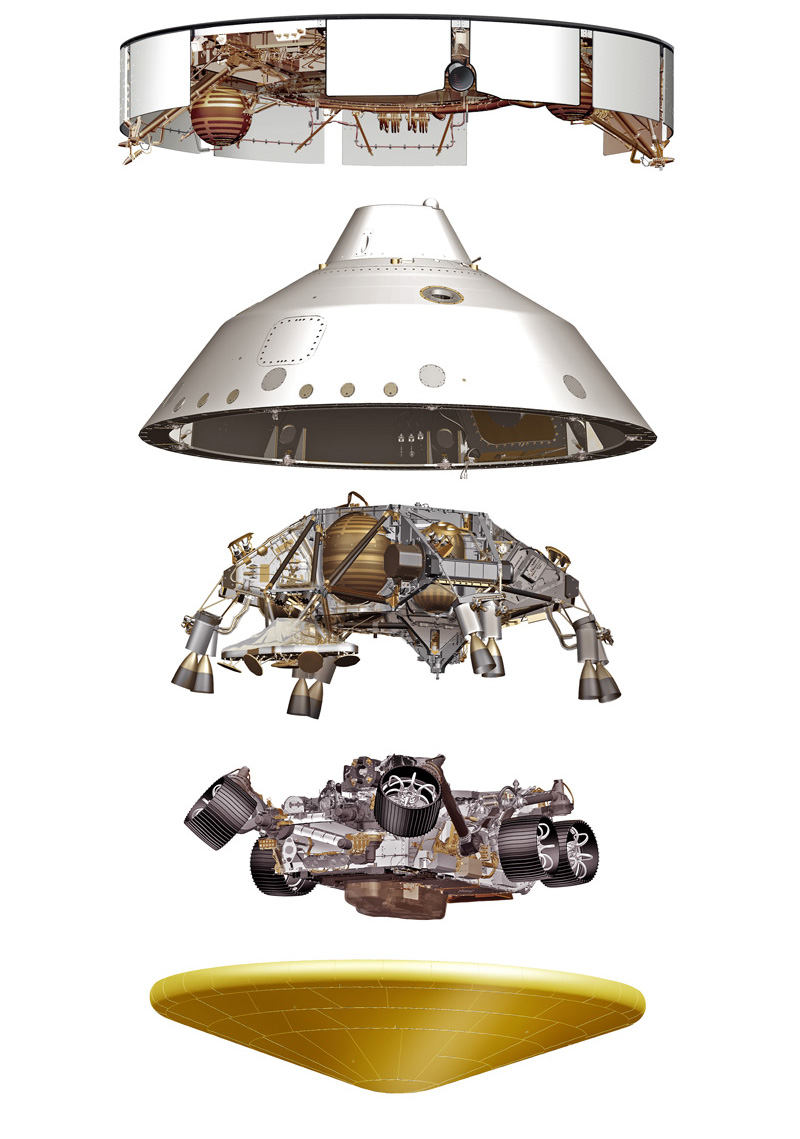New Mars Forums
You are not logged in.
- Topics: Active | Unanswered
Announcement
#126 2021-02-18 17:41:26
- SpaceNut
- Administrator
- From: New Hampshire
- Registered: 2004-07-22
- Posts: 29,917
Re: Ballistic Delivery of Supplies to Mars: Lithobraking
I gave the complete landing on this page
If this was a daylight side landing the air density is less the higher you go away from the surface so the drag would be less and speed would be higher.
https://www.nasaspaceflight.com/2021/02 … ro-crater/
lots of timing, speed, altitude and more.
The cost to deliver " concrete, steel rebar" does change much largely due to your still sending it from earth and would not want the concrete spread all over the place from impact plus you still need many more thing to prepare it for use to make a landing pad....We need many more things delivered to mars to make use of in a priority decision tree of level of importance.
The altitude testing on earth with no target ground for timing of speeds for impacting can not happen and even Everest might not be tall enough for a simulation let along starting free fall from zero from a balloon.
Offline
Like button can go here
#127 2021-02-19 06:07:31
- tahanson43206
- Moderator
- Registered: 2018-04-27
- Posts: 23,458
Re: Ballistic Delivery of Supplies to Mars: Lithobraking
For all regarding the Perseverance landing ...
I noticed the angle of approach was given as 15 degrees.
The velocity at the start of the run was closer to 5 km/s than to the 7 km/s worst case we've been discussing.
The point SpaceNut made in post #126 is interesting and worth further development .... I had assumed a concrete pad on Mars could be made from a combination of Earth supplied elements and materials from Mars itself.
I agree with SpaceNut that the components should be delivered intact, so experiments on Earth to show how to deliver various kinds of materials correctly are needed.
And that brings up SpaceNut's closing line in #126
If the testing is done in the United States, there are procedures in place used by many decades by the US Military, so the US Military would appear to be a logical partner. The FAA is already used to dealing with falling objects, and in any case, they would have jurisdiction.
I agree that Mount Everest is not tall enough for a test intended to yield 450 m/sec at impact, and in any case, Nepal and China would be approving authorities.
The United States is most certainly NOT the only Nation with the experience and expertise needed to perform experiments along these lines.
There may be recordings of observations of the results of falling objects that can be studied for intended ballistic delivery. GW Johnson recorded observations of impact experiments intended to destroy objects. It would appear that no data was collected about where the delivery package atoms went after the "landing", since that was not the purpose of the experiment.
In the leadership of SpaceNut, we have several questions to be addressed by this topic:
What components of a concrete landing pad can come from Earth (must come from Earth) and which can be collected on Mars?
Which Nations are amenable to supporting the collection of experimental data about ballistic delivery package design?
How are those individual Nations best approached to secure approval (a) and most importantly (b) investment to insure the success of the venture accrues to that Nation, and is denied to their competitors?
(th)
Offline
Like button can go here
#128 2021-02-19 18:17:57
- SpaceNut
- Administrator
- From: New Hampshire
- Registered: 2004-07-22
- Posts: 29,917
Re: Ballistic Delivery of Supplies to Mars: Lithobraking
Distance traveled to Mars: 293 million miles over six months

The only time it was near the value was after peak heating and in the glide....
Overall, there were 16 main sequence events in the Entry, Descent, and Landing choreography that had to reduce Perseverance’s velocity from 19,332.58 km/h to 0 km/h in just six minutes. Parachute deployment then followed at an altitude of 11.94 kilometers, with deployment initiated by the Range Trigger part of the landing system
Event Time of event Earth-Receive Time of event Altitude / Velocity
Cruise Stage Separation 15:26:53 EST 15:38:15 EST Altitude: 1,569 km Velocity: 16,728.4 km/h
De-spin 15:28:18 EST 15:39:40 EST Altitude: 1,348 km Velocity: 17,057.4 km/h
Cruise Balance Mass Ejection 15:28:50 EST 15:40:12 EST Altitude: 1,253 km Velocity: 17,191.8 km/h
Atmospheric Entry 15:36:53 EST 15:48:15 EST Altitude: 131.0 km Velocity: 19,202.2 km/h
Guidance Start 15:37:47 EST 15:49:09 EST Altitude: 59.6 km Velocity: 19,293.9 km/h
Peak Heating 15:38:08 EST 15:49:30 EST Altitude: 21.0 km Velocity: 10,849.5 km/h
Heading Alignment 15:39:12 EST 15:50:34 EST Altitude: 16.1 km Velocity: 3,697.6 km/h
SURF period begins 15:40:39 EST 15:52:01 EST Altitude: 13.7 km Velocity: 1,719.2 km/h
Parachute Deployment 15:40:56 EST 15:52:18 EST Altitude: 11.8 km Velocity: 1,518.9 km/h
Heat Shield Jettison 15:41:17 EST 15:52:39 EST Altitude: 9.7 km Velocity: 578.7 km/h
TRN Acquisition 15:42:17 EST 15:53:39 EST Altitude: 4.27 km Velocity: 322.5 km/hTRN Landing Solution Reached 15:42:24 EST 15:53:46 EST Altitude: 3.6 km Velocity: 313.3 km/h
Backshell Separation / Descent Stage Ignition 15:42:42 EST 15:54:04 EST Altitude: 2.1 km Velocity: 293.4 km/hDescent Stage Throttle Down 15:43:23 EST 15:54:45 EST Altitude: 0.21 km Velocity: 6.0 km/h
Rover Separation 15:43:27 EST 15:54:49 EST Altitude: 0.16 km Velocity: 9.9 m/s
Touchdown / Flyaway 15:43:42 EST 15:55:04 EST Altitude: 0.00 km Velocity: 0.00 m/s
http://citeseerx.ist.psu.edu/viewdoc/do … 1&type=pdf
MARS PATHFINDER CRUISE STAGE/ ENTRY VEHICLE SEPARATION DYNAMICS
Offline
Like button can go here
#129 2021-02-19 19:07:27
- tahanson43206
- Moderator
- Registered: 2018-04-27
- Posts: 23,458
Re: Ballistic Delivery of Supplies to Mars: Lithobraking
For Calliban re SpaceNut's post #128
From Google
Speed
1518.9 Kilometer per hour (per citation in #128)
=
421.916667 Meter per second
Formula
divide the speed value by 3.6
That value is ** under ** the 450 meters/second upper limit you reported finding.
I am under the impression a ballute may NOT be necessary, if this performance can be achieved consistently.
(th)
Offline
Like button can go here
#130 2021-02-19 19:44:02
- SpaceNut
- Administrator
- From: New Hampshire
- Registered: 2004-07-22
- Posts: 29,917
Re: Ballistic Delivery of Supplies to Mars: Lithobraking
This is what it looks like before getting rid of the cruise stage.
https://mars.nasa.gov/mars2020/timeline/cruise/
Thats the start of parachutes and long after the heat shield has done its job for entry that would damage going to mars....and with no parachute it hits the ground with a bang....as the heat shield and back shell are gone at that point which protects the cargo to that point.
Offline
Like button can go here
#131 2021-02-19 20:52:40
- tahanson43206
- Moderator
- Registered: 2018-04-27
- Posts: 23,458
Re: Ballistic Delivery of Supplies to Mars: Lithobraking
For SpaceNut .... Thanks for noting the value of your reporting!
Your report shows that the velocity Calliban is looking for is available without further development.
Altitude: 11.8 km Velocity: 1,518.9 km/h
The next phase of inquiry for ** this ** topic is to consider what velocity the vehicle would have sustained if it had continued forward without popping a parachute or taking any other evasive action.
As described in detail in earlier posts by Calliban, the payload has been protected all this time and will arrive at the surface intact. The Aeroshell will impact the terrain first, and will thus provide some of the crumple zone protection that you described in an earlier post in this topic.
I am looking forward to Calliban's analysis of the potential of this demonstrated package delivery system.
Edit#1: Here's a YouTube video showing one of the SpaceX landing pads under construction in Texas in 2019:
Landing Pad Concrete pour
The sound effects are the wind blowing by the microphone.
On Mars, of course, the "workers" would be teleoperation avatars with their controllers safely working from either a base in Phobos, or preferably, from one of RobertDyck's Large Ships.
(th)
Offline
Like button can go here
#132 2021-02-19 21:43:36
- kbd512
- Administrator
- Registered: 2015-01-02
- Posts: 8,349
Re: Ballistic Delivery of Supplies to Mars: Lithobraking
In recent decades, JPL's batting average for successfully landing on Mars is approaching a thousand, much like SpaceX's batting average for landing rocket boosters. If the engineers at SpaceX want to accelerate their Mars landing program, and if JPL wants to start landing very heavy and powerful payloads, then it'd be a good idea if both organizations shared notes.
Offline
Like button can go here
#133 2021-02-19 21:59:52
- SpaceNut
- Administrator
- From: New Hampshire
- Registered: 2004-07-22
- Posts: 29,917
Re: Ballistic Delivery of Supplies to Mars: Lithobraking
Jpl Had a mission for a red dragon sample mission but the legs through the heat shield killed it.
http://newmars.com/forums/viewtopic.php?id=7336
http://newmars.com/forums/viewtopic.php?id=6078
Offline
Like button can go here
#134 2021-02-20 13:24:24
- SpaceNut
- Administrator
- From: New Hampshire
- Registered: 2004-07-22
- Posts: 29,917
Re: Ballistic Delivery of Supplies to Mars: Lithobraking
For SpaceNut re #948
Thank you for your encouragement!
***
It is possible very few humans would be interested in this next focus, but your kind words provide an excuse to mention it ...The daily Mars Calendar report allows a **really* dedicated reader to follow the movement of Mars along its ellipse, much as Tycho did using the crude instruments he had available. With the modern French web site computations, the interested person can see progress in detail.
Plus prefix means Mars is moving away from the Sun. Aphelion will occur near 70 degrees Ls (per www.planetary.org)
Distance of Mars from the Sun is given by theskylive.com as: 235,358,005 km Difference is +187308 <= 7374 km/hour at 8.8 on 02/20 (time:8:48
Distance of Mars from the Sun is given by theskylive.com as: 235,170,697 km Difference is +166548 <= 7402 km/hour at 7.4 on 02/19 (time:7:42)
Distance of Mars from the Sun is given by theskylive.com as: 235,004,149 km Difference is +188849 <= 7435 km/hour at 8.9 on 02/18 (time:8:54)It is easy to see that Mars is slowing down in its progress away from the Sun. Aphelion is predicted to occur somewhere around Longitude 70 degrees. At that time, the rate of progress of Mars away from the Sun will drop to zero, and shortly afterward the planet will begin it's long "fall" inward.
I have worked out the procedures needed to capture the rate of progress accurately, so the daily reports are closer to reality than had been the case earlier.
Year 36 should contain accurate Rate of Progress figures, within the margin of error of 1 terrestrial minute.
(th)
This work aids in calculations as it relates to obital mechanics dealing with earth to mars launch of crew and payloads as intersect and course correction plus arrival day and time. It also works for the return trip as well.
Offline
Like button can go here
#135 2021-02-21 11:45:53
- GW Johnson
- Member
- From: McGregor, Texas USA
- Registered: 2011-12-04
- Posts: 6,104
- Website
Re: Ballistic Delivery of Supplies to Mars: Lithobraking
TH;
I sent some stuff to you to forward to Calliban. It pretty much describes what I came up with for ballistic delivery to Mars.
GW
GW Johnson
McGregor, Texas
"There is nothing as expensive as a dead crew, especially one dead from a bad management decision"
Offline
Like button can go here
#136 2021-02-21 12:09:48
- tahanson43206
- Moderator
- Registered: 2018-04-27
- Posts: 23,458
Re: Ballistic Delivery of Supplies to Mars: Lithobraking
For GW Johnson re #135
Thanks for the heads up! I was busy this morning but free now so will take care if it next.
I'm hoping ** someone ** will start developing this as a viable business! The number of cargo delivery services on Earth (appear to me to ) far exceeds the number of human transport services. I am confident the same ratio will continue far into the future.
This forum is ahead by leaps and bounds due to the mix of personalities and talents in residence here.
Without someone like Void, for example, the regular members would be stuck in patterns already proven on Earth over previous millennia.
With the inspiration of Void, the expertise of regular members can work on breakthrough ideas until they are practical.
I hope that is what is happening now.
(th)
Offline
Like button can go here
#137 2021-02-21 12:44:15
- RobertDyck
- Moderator
- From: Winnipeg, Canada
- Registered: 2002-08-20
- Posts: 8,296
- Website
Re: Ballistic Delivery of Supplies to Mars: Lithobraking
On Mars, of course, the "workers" would be teleoperation avatars with their controllers safely working from either a base in Phobos, or preferably, from one of RobertDyck's Large Ships.
Oh, please no. If you want to go to Mars, then go to Mars. The safest place in our solar system is the surface of Mars. Second only to the surface of Earth. Mars has real natural gravity (37.941% G), Phobos has 581.4 µG (0.0005814 G = 0.05814% G). Mars has an atmosphere that blocks micrometeoroids; they burn up 30km above the surface. Phobos has vacuum, so pelted with micrometeoroids. Most micrometeoroids are the size of a grain of sand or smaller, hull shielding can block that, but ones the size of a pebble can get through. Pebble size meteors will still burn up in Mars atmosphere, kilometres above the surface. Phobos or Mars orbit has no radiation shielding. Yes, my ship would have a water wall on the sun-facing wall of the habitation ring. And I would like to develop a mini-magnetosphere, which hopefully would reduce radiation while in interplanetary space to equal that of ISS. Mars doesn't have a magnetic field; some mountains have a very weak magnetic field, but it's not planetary. That means Mars orbit has the same radiation as interplanetary space. The surface of Mars has dirt, so you can build a habitat with multiple metres or multiple feet of dirt piled on top. With enough, that would block all radiation.
Why would you suggest that? GW Johnson's concerns about landing Starship on Mars? Legs digging into Mars dirt? Elon is planning to land unmanned cargo Starships first, to preposition supplies before the first settlers arrive. Of course I still think a better plan would be initial scouting with a Mars Direct size ship, then construct a small base the size of the Mars Homestead Hillside Settlement, then with 12 workers living in comfort, they would build landing facilities, habitat and life support for the first 100 settlers. But that's me...we'll see what Elon does.
Offline
Like button can go here
#138 2021-02-21 16:56:44
- SpaceNut
- Administrator
- From: New Hampshire
- Registered: 2004-07-22
- Posts: 29,917
Re: Ballistic Delivery of Supplies to Mars: Lithobraking
This adds to desire
There ** should ** be more than one Earth-based business that develops in this specialty.
On Earth, there (appear to me to be) more cargo transportation systems than there are human transportation ones.I expect the ratio of cargo to human transport we see on Earth to continue into Solar System activity.
In fact, that ratio is evident already ... the number of spacecraft launched with cargo far exceeds the number launched with humans.
Business model fails as mass goes up for having a sustainable delivery wants from those on mars surface when it stops out numbering the crewed vehicles. Same problem with the ISS as we deliver consistently send goods with dragons and cygnus but once you throw a starship payload its now in slow mode for the need and profit disappears. Next up would be deliveries by faster from orbit ship deliveries.
Planned constant good needs are a must.
Offline
Like button can go here
#139 2021-02-21 17:28:47
- Calliban
- Member
- From: Northern England, UK
- Registered: 2019-08-18
- Posts: 4,269
Re: Ballistic Delivery of Supplies to Mars: Lithobraking
I am aware of the need to continue this topic, but have run short of time lately.
Regarding the construction of a Starship landing pad on Mars, I think that deserves a topic of its own. The concern as I understand it, is that the point loads imposed by the weight of the Starship through its four landing legs, may exceed the crush strength of the local regolith. So we need a way of spreading that load to avoid destabilising the regolith. One way of doing that would be to build up a landing pad from successive layers of rocks and compressed clay. The top layer would be made from iron rich clays with a little carbon mixed in. When smoothed off and flat, we would heat the layer using a radiant tungsten resistance heater up to the melt point of silica (1600C), allowing the surface to partially melt, sinter and for the carbon to reduce the iron oxide. Small sections would be completed one at a time. By finish, there should be a strong and hard iron rich surface coating, made of a mixture of silicate and reduced iron oxide. Many times harder and stronger than concrete. And sitting on top of a landing pad, with layers of clay and stone design to gradually spread weight to the underlying soil.
edit
topic has been created
Last edited by Calliban (2021-02-21 17:33:45)
"Plan and prepare for every possibility, and you will never act. It is nobler to have courage as we stumble into half the things we fear than to analyse every possible obstacle and begin nothing. Great things are achieved by embracing great dangers."
Offline
Like button can go here
#140 2021-02-21 18:02:54
- tahanson43206
- Moderator
- Registered: 2018-04-27
- Posts: 23,458
Re: Ballistic Delivery of Supplies to Mars: Lithobraking
For SpaceNut .... Calliban has suggested a topic for construction of a landing pad on Mars.
Where would you like to create such a topic?
It is indirectly related to Interplanetary Transportation, but perhaps there is a better fit?
For Calliban re #139
Best wishes for successful completion of your projects (a) and (b) other demands on your time!
When you get a chance to return to this topic ... (and pending a decision by SpaceNut for a new topic about landing pads) ...
Would it make sense to send that "iron rich clay" from Earth?
If you shipped the building materials you need from Earth (it seems to me) you would have a better chance of offering a prospect of success to your funder.
The machinery needed to implement your plan needs to be developed, if it does not already exist.
Despite the protestations of some that workers should be on the surface, I would like to point out that the ** purpose ** of the landing pad is to increase chances of successful delivery of humans to the surface.
What would a complete shipment of material, tools and power sources look like?
Can the entire package be assembled in time for the next launch window, which is reported (by Google) to be September 2022 for landing in May 2023?
The customer (in this case) would be SpaceX, and they would (probably) be the main provider of launch services.
The companies SpaceX has hired to set up launch pads might be a good match for this challenge.
(th)
Offline
Like button can go here
#141 2021-02-21 18:12:30
- tahanson43206
- Moderator
- Registered: 2018-04-27
- Posts: 23,458
Re: Ballistic Delivery of Supplies to Mars: Lithobraking
For RobertDyck re #137
Pretty funny!
However, aside from the chuckle factor, you've identified a need to be addressed: How to contract with customers?
You're going to be beholden to your funders. The extent to which you maintain control of your project is going to depend mightily upon your negotiating skills.
Your customer (in this case a consortium wanting to build one or more landing pads on Mars) is going to insist upon making their own decisions about how to proceed. If you have a vessel ready in time for them to consider booking a flight, the restrictions you may wish to place on the use of the vessel, (in cooperation with your funders) will determine whether the prospect decides to go with your venture or to look for another provider.
It seems to me you (and your funders) would be perfectly justified in requiring that the customer should take all reasonable precautions to protect your investment from harm, although what ** that ** will look like when the vessel is outfitted and ready to go seems (to me at least) difficult to predict.
Perhaps a minimum requirement is for the customer to pay for insurance to cover replacement of the vessel if they are responsible for its loss. On the other hand, if your vessel is unsafe and the expedition is lost due to malfeasance by your organization or the people you hire to fly the ship, then you'll want to have insurance coverage, which would have to come out of the fee you charge for booking the ship.
On balance, it seems to me opting for a less risky flight plan might work best for all concerned.
(th)
Offline
Like button can go here
#142 2021-02-21 18:17:42
- SpaceNut
- Administrator
- From: New Hampshire
- Registered: 2004-07-22
- Posts: 29,917
Re: Ballistic Delivery of Supplies to Mars: Lithobraking
Created topic for the Starship concrete Mars landing pad for unbelievers to think starship does not need one and that Nasa would tell musk anything for landing....
Offline
Like button can go here
#143 2021-02-21 23:20:25
- RobertDyck
- Moderator
- From: Winnipeg, Canada
- Registered: 2002-08-20
- Posts: 8,296
- Website
Re: Ballistic Delivery of Supplies to Mars: Lithobraking
tahanson43206,
I don't see how you came to THAT conclusion from what I posted. I said leaving crew parked in Mars orbit indefinitely with absolutely no chance of landing on the planet is unsafe. Safety requires individuals down on the surface as soon as possible. You've claimed to be supportive of my ship design. My discussion thread started by saying Elon's tweet that the next ship after Starship would be twice as wide and twice as high, and I believe that design is unreasonable! A better design would be...blah. You liked the design, and it has progressed. It grew, and has some detail. I was a pre-schooler in the 1960s; I watched the last 2 missions of Mercury as they happened on TV with my mother, all of Gemini, and all of Apollo. My dream when I was a child was to be the aerospace engineer who designed the spacecraft to carry the first humans to Mars. Doesn't look like that will happen, but building the spacecraft to carry Mars settlers would be good. You got me excited! Using terms like "malfeasance" is not supportive! Claiming that my design is "risky" is not supportive!
As for my design, let me point out some history. After Robert Zubrin and his partner David Baker came out with Mars Direct, several mission planners have notices key features that are brilliant! Many people have wanted a Mars sample returned to Earth. Mission planners noticed that if you use ISPP from Mars Direct, applied to an unmanned sample return mission, then the mission becomes affordable. This got a lot of people excited! This mission was approved and detailed planning proceeded. Then some science types who treat engineers as "janitors" didn't like the idea of using new technology on "their" mission. So they removed ISPP. That required hauling propellant for return all the way from Earth. That drastically increased cost. The cost increase did not go over with politicians, so the mission was cancelled. This cycle has been repeated 3 times that I'm aware of, and probably more. Now we have Perseverance on Mars collecting samples, which will be placed in a container the size of a coconut and dumped on the surface of Mars. The hope is some future mission will "somehow" collect the samples and return them to Earth. But proposals to do so are extremely elaborate and expensive. Anything beyond Perseverance has not been approved. Any practical plan to return samples from Mars will include collecting samples by the mission with the return vehicle, so samples collected by Perseverance never will be returned.
Obsessing over hauling propellant from Earth has that consequence. The mission gets cancelled. Have you learned? Can we discuss this in the "Large scale colonization ship" thread?
Offline
Like button can go here
#144 2021-02-22 06:25:41
- tahanson43206
- Moderator
- Registered: 2018-04-27
- Posts: 23,458
Re: Ballistic Delivery of Supplies to Mars: Lithobraking
For RobertDyck re Use of Large Ship for Onsite Work Crew at Mars ...
The Large Ship design you've proposed is a candidate to transport a work crew to Mars. It needs to be able to protect the passengers from radiation.
If it cannot provide protection from radiation, then perhaps a tweak to the design will improve it's performance.
The Large Ship is in this topic because it is the only viable option (that I know of) to deliver a work crew to the vicinity of Mars. No doubt other designs will become available in the near future, but at this point, you have this specialty to yourself.
However, I agree that improving the design can and should happen in the Large Ship topic.
(th)
Offline
Like button can go here
#145 2021-02-22 18:31:29
- SpaceNut
- Administrator
- From: New Hampshire
- Registered: 2004-07-22
- Posts: 29,917
Re: Ballistic Delivery of Supplies to Mars: Lithobraking
https://en.wikipedia.org/wiki/List_of_c … sion_plans
https://en.wikipedia.org/wiki/Human_mission_to_Mars
when are the best times
Conducting mission for mars with what we have will sort of be like this
Granted I think we can do better than a ton or two but the landings will be no dragon or skycrane as they are.
The skycrane is a set of canted engines like as the red dragon or crewed version. As I indicated cargo will not need the heavy pressure vessel.
Here is a chart for metals or alloys that will be possible for soldering the electrical connections for the circuit board connections 
Offline
Like button can go here
#146 2021-02-23 07:18:30
- tahanson43206
- Moderator
- Registered: 2018-04-27
- Posts: 23,458
Re: Ballistic Delivery of Supplies to Mars: Lithobraking
For SpaceNut re #145
Thank you for the image (and commentary and links) in this post! If a forum reader looks closely at the image provided by SpaceNut in this post, you will see a ballistic delivery going on in the background! Nice! Good work, SpaceNut!
I'd like to see this topic continue to develop methodically, now that the basic calculations have been performed by Calliban and GW Johnson, and with the recent demonstration of exactly what GW Johnson had predicted, in the landing of Perseverance. The aerobraking performed by the aeroshell for the probe brought the velocity down to the level predicted by Calliban as the minimum needed for a ballistic delivery.
I'd like to invite forum members who may be interested in helping to move this topic along, to find out who manufactured the aeroshell and related steering and navigation components for the Perseverance lander.
Well, Google appears to have the answer:
Lockheed Martin
At 14.9 feet in diameter, this Lockheed Martin-built aeroshell is one of the two largest ever made for a planetary mission — equal in size to its predecessor, the Mars Science Laboratory aeroshell.
Aeroshells: Keeping Spacecraft Safe | Lockheed Martin
www.lockheedmartin.com › en-us › capabilities › space › aeroshell-space
14.9 feet converts to 4.542 meters
Google came up with this set of numbers for the rover ...
This article documents a current or recent spaceflight.
Perseverance
Length
2.9 m (9 ft 6 in)
Diameter
2.7 m (8 ft 10 in)
Height
2.2 m (7 ft 3 in)
Launch mass
1,025 kg (2,260 lb)
Perseverance (rover) - Wikipedia
en.wikipedia.org › wiki › Perseverance_(rover)
What I'm not (yet) clear on is what that mass total includes.
What I'm looking for is the payload mass separate from the mass of the vehicle that entered the atmosphere of Mars.
The NASA example appears to show the way forward.
Lockheed Martin would appear to be in a position to provide components for a wrapper for a ballistic delivery package.
I think I saw hints that Lockheed Martin has published information about the aeroshell.
If anyone would be willing to follow up it would be helpful!
The NASA package was able to steer itself precisely through the atmosphere. Package Delivery will require the same or superior accuracy.
Edit#1: here is a video presentation by Lockheed Martin that shows the Perseverance aeroshell and backshell ...
https://www.lockheedmartin.com/en-us/ca … space.html
For Ballistic Delivery, these would need to be mass produced.
(th)
Offline
Like button can go here
#147 2021-02-23 18:48:33
- SpaceNut
- Administrator
- From: New Hampshire
- Registered: 2004-07-22
- Posts: 29,917
Re: Ballistic Delivery of Supplies to Mars: Lithobraking
First commodity for a manned flight drop off on planetary approach is collected waste that has been segregated so as to make delivery to the surface for a variety of purposes. From a large bag of poop to aid in terraforming mars soil for use in growing plants and another could be recycled plastics....These would be hard landed to and medium deliver packaged.
Offline
Like button can go here
#148 2021-02-25 12:47:06
- SpaceNut
- Administrator
- From: New Hampshire
- Registered: 2004-07-22
- Posts: 29,917
Re: Ballistic Delivery of Supplies to Mars: Lithobraking
The mars landing EDL profile
http://exrocketman.blogspot.com/2018/09 … -mars.html
Retro-propulsion is necessary from the moment hypersonics end at about 0.7 km/s speeds. Altitudes are on the order of only 5 km, so that impact is but seconds away, unless retropropulsion is on the order of 3-4 gees.
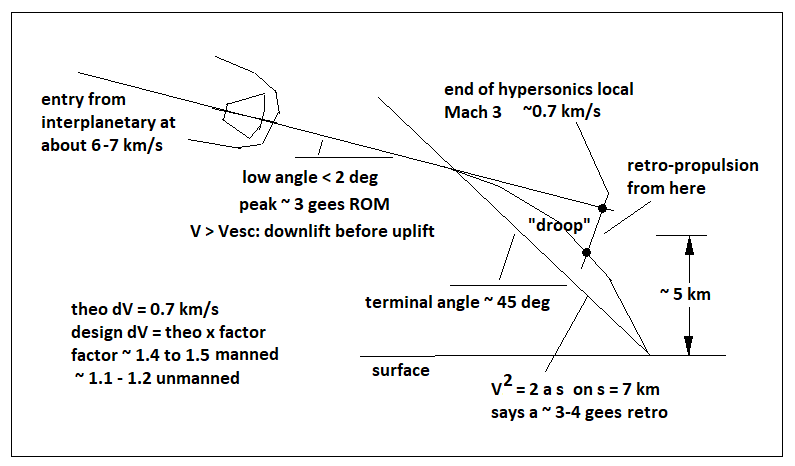
retro-propulsion lander that is one stage and not reusable, can have at most a payload fraction of about 50%, using long-term storable propellants, such as MMH-NTO.
Of course clean sheet would take longer and even thou the Red Dragon is out as well.
The crewed Dragon we have not looked at yet but it may have promise and the cargo Dragon is run here http://exrocketman.blogspot.com/2017/03 … -data.html
This is one technology that we are waiting to see if its ever going to see the light of day for even higher payload mass delivery to mars surface:
typical dragon layout of the internal diagram: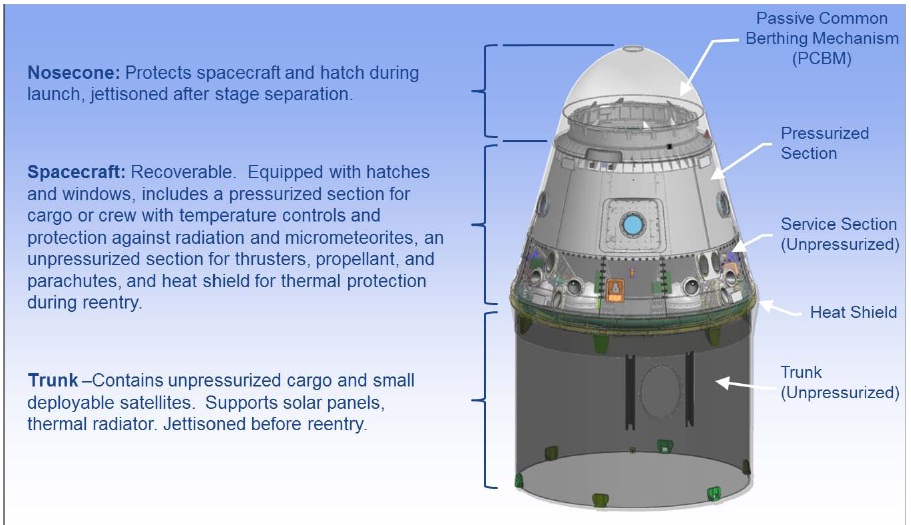
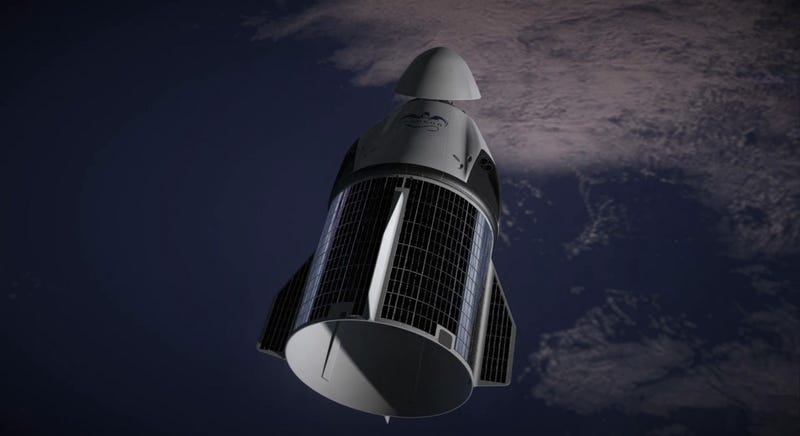
Use the trunk as the service cruise module plus extra fuel to get the ship to mars.
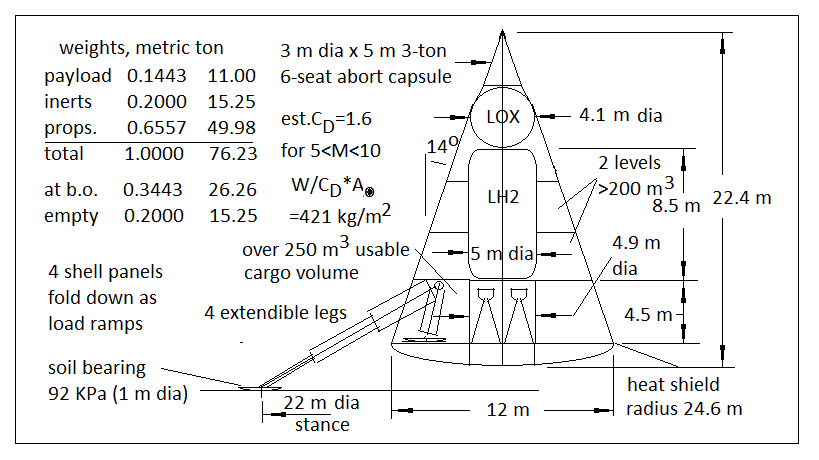
This is how a cygnus normally looks packed away for launch.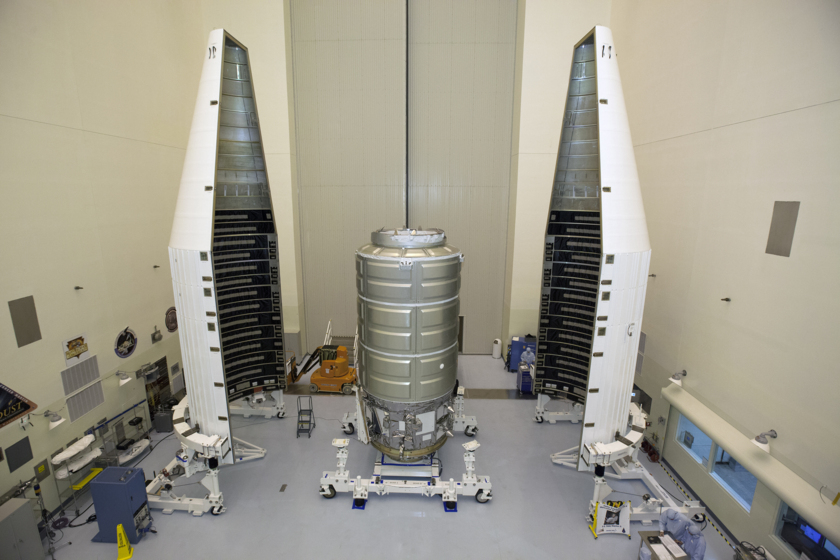
The payload shrouds are tough enough to survive the edl of mars to not need a pressure vessel for some items that we would want to deliver for use.
Offline
Like button can go here
#149 2021-03-13 10:27:56
- SpaceNut
- Administrator
- From: New Hampshire
- Registered: 2004-07-22
- Posts: 29,917
Re: Ballistic Delivery of Supplies to Mars: Lithobraking
Here is the parachute information's for what we deliver to the surface.
The answer to the air pressure is in the 
This it from high above the surface as imaged from High Resolution Imaging Experiment (HiRISE) camera aboard NASA's Mars Reconnaissance Orbiter (MRO).
This one is not the parachute of the landings but it shows how the parachute inflates to be able cause drag....

This page has a video of it opening plus shows the heat shield or back shell dropping
Offline
Like button can go here
#150 2021-03-13 10:29:34
- SpaceNut
- Administrator
- From: New Hampshire
- Registered: 2004-07-22
- Posts: 29,917
Re: Ballistic Delivery of Supplies to Mars: Lithobraking
It would open in exactly the way that you see it opening. Remember, the parachute is deployed at a descent speed of about 1000mph (450m/s). At this speed and a local atmospheric density of about 6 grams per cubic metre (at a height of 10km, say), the dynamic pressure on the parachute would be 1.2KPa or 120 kg-force per square metre, assuming a drag coefficient of one. That is equivalent to the weight of a man (in Earth gravity) acting on every square metre of the chute.
Easily enough to open a thin fabric parachute. In fact, it would be enough to tare the chute into shreds if it weren't made from such high strength polymers.F = Cd x A x Rho x V^2
Offline
Like button can go here
